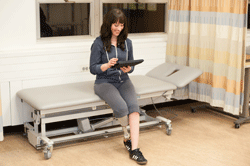

The Prosthetic Limb Users Survey of Mobility (PLUS-M™) is a self-report instrument for measuring mobility of adults with lower limb amputation. It has been rigorously developed using modern psychometric methodology and is intended for use in clinical practice and research.
PLUS-M™ instruments measure prosthetic users’ mobility (i.e., the ability to move intentionally and independently from one place to another). PLUS-M™ questions assess respondents’ perceived ability to carry out actions that require use of both lower limbs, ranging from household ambulation to outdoor recreational activities. The described activities relate to two primary forms of movement, locomotion (i.e., movement in a continuous, repeatable pattern) and/or postural transitions (i.e., movement from one position to another or one type of activity to another).
 Activities described by PLUS-M™ questions are often qualified by language that describes a specific setting or situation in which the activity would be performed (e.g., walking down stairs with a railing). Unintentional movements (e.g., falls or stumbles) or movements performed with the physical assistance of another person (e.g., assisted transfers) are not measured with this instrument. Further, PLUS-M™ instruments are not intended to measure mobility with seated or wheeled assistive devices (e.g. a scooter or wheelchair).
Activities described by PLUS-M™ questions are often qualified by language that describes a specific setting or situation in which the activity would be performed (e.g., walking down stairs with a railing). Unintentional movements (e.g., falls or stumbles) or movements performed with the physical assistance of another person (e.g., assisted transfers) are not measured with this instrument. Further, PLUS-M™ instruments are not intended to measure mobility with seated or wheeled assistive devices (e.g. a scooter or wheelchair).
All PLUS-M™ questions begin with “Are you able to…,” followed by a description of the activity. No time frame is provided and respondents’ current perception of their mobility is implied. PLUS-M™ responses reflect the difficulty with which the respondents’ report they could perform the activity. Response options include “without any difficulty,” “with much difficulty,” “with some difficulty,” “with a little difficulty,” and “unable to do.” It is important to note that PLUS-M™ questions assess respondents’ reported ability to perform activities rather than individuals’ actual performance of that activity.
Construct: PLUS-M™ instruments measure prosthesis users’ mobility (i.e., their ability to move intentionally and independently from one place to another). Individual PLUS-M™ questions assess respondents’ perceived ability to carry out specific activities that require use of both lower limbs. PLUS-M™ questions cover movements that range from basic ambulation (e.g., walking a short distance indoors) to complex activities (e.g., hiking for long distances over uneven ground). PLUS-M™ response options reflect the degree of difficulty with which respondents report they can carry out these activities.
Intended applications: PLUS-M™ instruments are intended for use in research and clinical care.
Intended population: PLUS-M™ instruments are intended for use with adults (age 18+) with lower limb amputation who have experience using a prosthesis.
 Formats: PLUS-M™ instruments are based on a set of 44 calibrated questions called the PLUS-M™ item bank. The PLUS-M™ 7- and 12-item short forms included in this guide are subsets of questions in the PLUS-M™ item bank. All items on the PLUS-M™ 7-item short form are also included in the PLUS-M™ 12-item short form. The PLUS-M™ Computer Adaptive Test (CAT) offers an optimal combination of high measurement precision and low administrative burden.
Formats: PLUS-M™ instruments are based on a set of 44 calibrated questions called the PLUS-M™ item bank. The PLUS-M™ 7- and 12-item short forms included in this guide are subsets of questions in the PLUS-M™ item bank. All items on the PLUS-M™ 7-item short form are also included in the PLUS-M™ 12-item short form. The PLUS-M™ Computer Adaptive Test (CAT) offers an optimal combination of high measurement precision and low administrative burden.
Administration and scoring time: PLUS-M™ short forms require 2-3 minutes to administer and 1-2 minutes to score. The PLUS-M™ Computer Adaptive Test (CAT) can generally be administered and scored in under 2 minutes.
Score: PLUS-M™ instruments each provide a T-score that ranges from 17.5 to 76.6.
Score interpretation: PLUS-M™ T-scores are referenced to the PLUS-M™ development sample (n=1091 lower limb prosthesis users) described in this manual. A T-score has a mean of 50 and a standard deviation (SD) of 10. A PLUS-M™ T-score of 50 represents the mean mobility reported by the development sample. A higher PLUS-M™ T-score corresponds to greater mobility. Individual PLUS-M™ T-scores may also be compared to those reported by the development sample or to those reported by subgroups (by level of amputation, etiology of amputation, gender, and age) within the development sample. Development sample data is included in the PLUS-M™ Short Form Users Guide.
Languages: PLUS-M™ instruments are available in US English. Translations of PLUS-M™ instruments are also available in multiple languages.